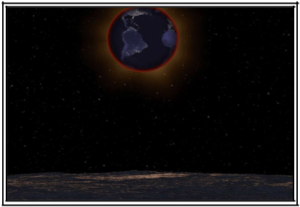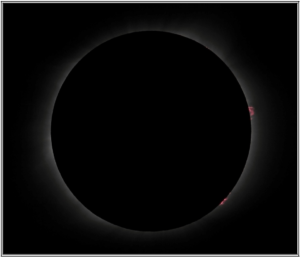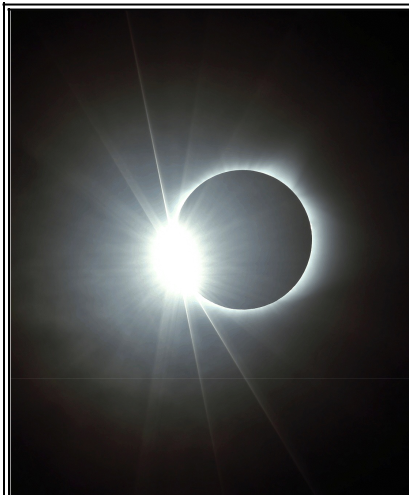by Jeff Hutton

Hello Astronomers! In the last issue, we talked about shadows. Shadows are why we have special events like lunar and solar eclipses. Let’s look again at lunar eclipses. We know that the Earth casts a shadow out into space in the direction of the anti-solar point. Remember, that’s the point directly away from the direction of the sun.

Can we ever see evidence of Earth’s shadow besides when there is an eclipse of the moon? Yes!
 I took this picture last fall on a clear evening just as the Full Moon was rising in the northeast. Look carefully at the colors of the sky. Near the top is the blue sky that we see during a sunny day. Now start moving downward where the color turns a little orange and then below that what do you see? That darker area is called the Belt of Venus. That’s not a scientific term. It’s what’s called a “folk term” that has nothing to do with the planet Venus but even astronomers still use that term.
I took this picture last fall on a clear evening just as the Full Moon was rising in the northeast. Look carefully at the colors of the sky. Near the top is the blue sky that we see during a sunny day. Now start moving downward where the color turns a little orange and then below that what do you see? That darker area is called the Belt of Venus. That’s not a scientific term. It’s what’s called a “folk term” that has nothing to do with the planet Venus but even astronomers still use that term.
What you are seeing is the outer edge of shadow of the Earth close-up as it projects into space. The moon isn’t near the center of the Earth’s shadow so there will be no lunar eclipse tonight!
 Remember this illustration from last time? It’s an artist’s drawing of what the Earth must look like from the Moon while a lunar eclipse is going on. Here we’re totally in the dark shadow of the earth. Did you know that the Earth has two shadows?
Remember this illustration from last time? It’s an artist’s drawing of what the Earth must look like from the Moon while a lunar eclipse is going on. Here we’re totally in the dark shadow of the earth. Did you know that the Earth has two shadows?

Look at the picture above, courtesy of the National Natural History Museum. We can see that the Earth casts two shadows. An outer, lighter, shadow called the penumbra and an inner, darker shadow called the umbra. The anti-solar point is all the way to the right, off the picture. So in my second photograph, what we call the Belt of Venus, is really just the edge of the penumbra going out into space. It’s pretty cool to see a thing for yourself, isn’t it?
When the Moon enters Earth’s dark umbra shadow, we see the coppery orange moon that is reflecting the color of the sunset and sunrise from all around the earth. Here’s my picture from the 2014 lunar eclipse.

Now, what about a solar eclipse? First, remember my warning from last time!
This is the ONLY time it is safe to look towards the Sun without special glasses.
Please try to see at least one total eclipse of the sun during your lifetime! There is one coming up in 2024. I’m planning to go! How about you? Look for further announcements. In 2017 I joined a group from Berea’s Union Church to view and take pictures of the solar eclipse. We were all fortunate to live in Kentucky because Hopkinsville was the best place on Earth to see the eclipse. For more about that, join us at the FOC when we can again get together. I will give my presentation, Chasing the Moon’s Shadow.
Because solar eclipses are daytime events, it’s fun to watch and hear what goes around you on the ground and in the air even before totality, beginning when the Moon completely covers the Sun.

When the moon first takes a ‘bite’ out of the sun, things around you look pretty normal. Looking only through the viewfinder, not directly at the sun, I took this picture just as the landscape began to be darkened by the Moon’s shadow. Do you see the crescent-shaped sun at the center?

As the sliver of Sun gets thinner weird things happen. Birds start to flock together, as if its evening. Even when just a tiny bit of the sun’s disk is showing, its light can still burn your eyes. Don’t look yet! I used a special filter to get this picture. Shadows from sunlight get super-sharp.

This is how that tiny sliver of sun looked when I removed a special filter. We call this the “diamond ring”. By now birds are nesting in the trees and some night insects start to sing.

Totality! The bright disk of the Sun is totally covered by the Moon. This image on the right shows the Sun’s outer crown, or corona.
Below is a view of the inner corona, which is part of the Sun’s own atmosphere. Did you know that the corona is much hotter than the surface of the sun?

This picture also shows a little bit of corona and solar prominences, the little pink blobs on the right side of the sun. These ‘little’ blobs are larger than the Earth!
When the Moon moves off and away from the sun, everything returns to normal. Too bad.
So why don’t we see lunar eclipses and solar eclipses every month?
Let’s look at that question next time.
For a printable PDF click HERE.


0 Comments